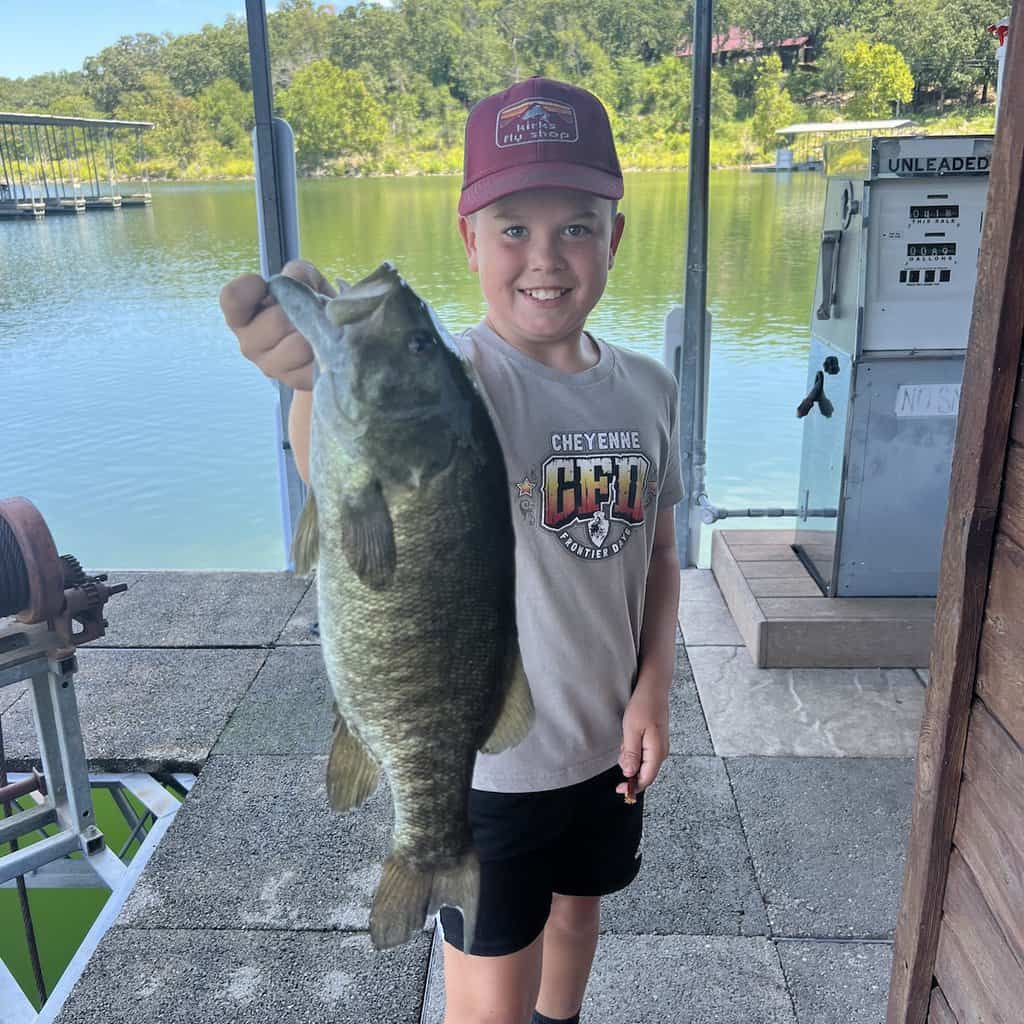Nestled in the Ozark Highlands south of Tahlequah, Tenkiller Ferry Lake is one of the state’s most popular bodies of water for fishing, scuba diving, and boating.
Its crystal clear waters are home to numerous fish species, so you’re destined to love Lake Tenkiller no matter your angling preference.
I’ve camped at and fished this lake many times. As a matter of fact, it’s one of my favorite places to visit. I try to make at least one trip here every year, and over the years, I’ve picked up a few tips and tricks that I’m about to reveal below.
Lake Tenkiller Bass Fishing
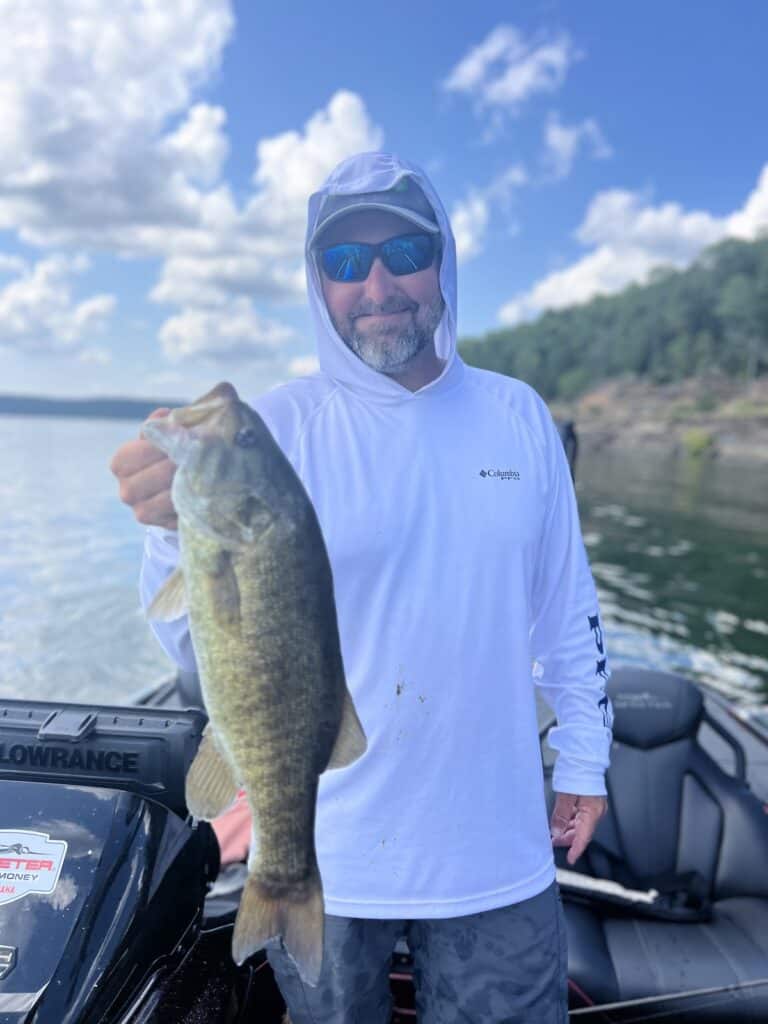
Tenkiller Lake is one of the best bass fishing lakes in Oklahoma. In college, I fished a tournament here in the fall and learned three species of black bass are in the lake.
Smallmouth, largemouth, and spotted bass all have a predictable spawning cycle you can use to understand where each will most likely be, depending on the time of year you’re visiting.
Black Bass Spawning Cycle
In the spring, all three species begin moving shallow; however, since the water is so clear, shallow is a relative term for all species—largemouth bass spawn in the shallowest waters, then smallmouth and spotted bass.
Spawning depth can range from one foot to 10 feet deep in hard-bottom areas like rocky points and pea gravel coves.
As summer sets in, largemouth bass head for the shaded areas, such as brush piles, docks, and creek channels, while smallmouth prefer rock piles and areas with a bit of current. Spotted bass excel in more open water, so that’s most likely where you’ll find them.
As summer winds down and fall sets in, bass follow the bait fish back to the shallows to feed up before winter, where they’ll return to deeper water.
Now that we have a general understanding of where bass will be located throughout the year, it’s time to get into some specifics for each species.
Smallmouth Bass
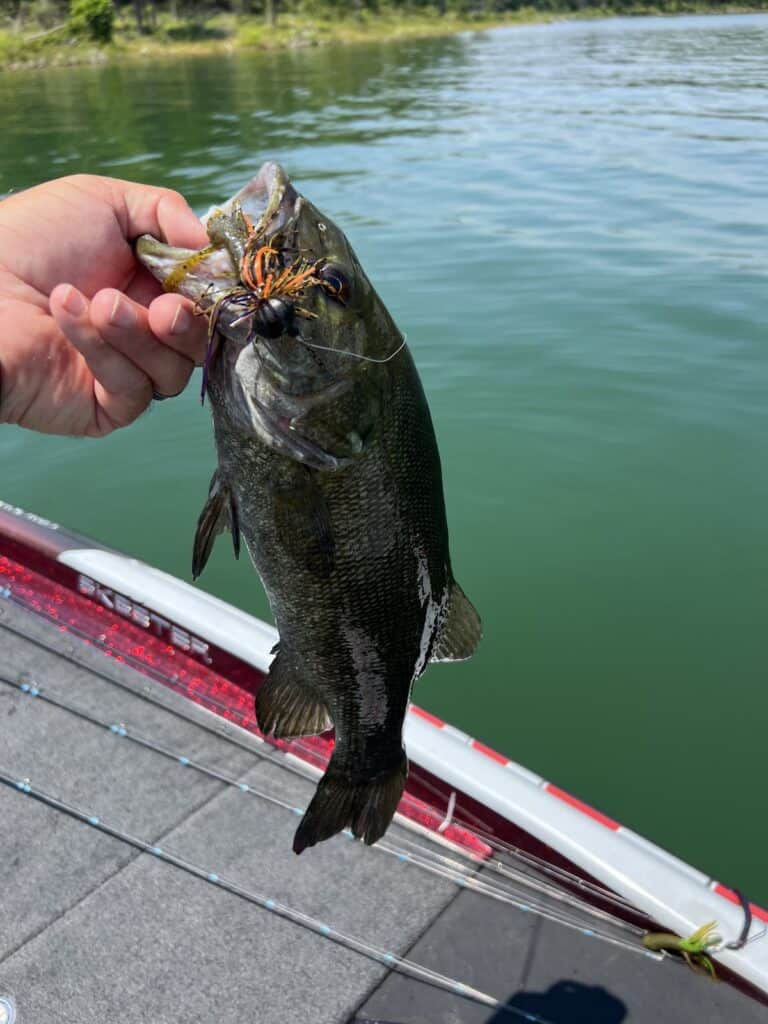
Let’s start with smallies.
As their name implies, smallmouth bass have a small mouth compared to other species. This characteristic is most important for lure selection. To get more bites, I always downsize my lures when targeting bronzebacks.
My favorite lures in shallow water are small jigs, crankbaits, spinnerbaits, Mepps spinners, and swimbaits.
The drop shot and wacky rig are two of my favorite soft-plastic rigs for smallmouth bass.
Since the water is clear, I use natural insect and crawdad colors and translucent shad colors such as green pumpkin and silver. Tenkiller smallmouths’ primary food sources are insect larvae, crayfish, and small shad.
Smallies thrive in areas with current. So if you’re targeting smallmouth, head up the river or down to the islands near the dam. They’re often caught on main lake points and rock piles, especially when the dam is releasing water.
Locations to find these fish include isolated rock boulders, rock banks, and other rocky structures.
During the spawning season, look for pea gravel banks where it continues into the water. Pea gravel points are rare, but they are among the best fishing spots on Lake Tenkiller for smallmouth, fishing guide Josh Teply said.
Largemouth Bass
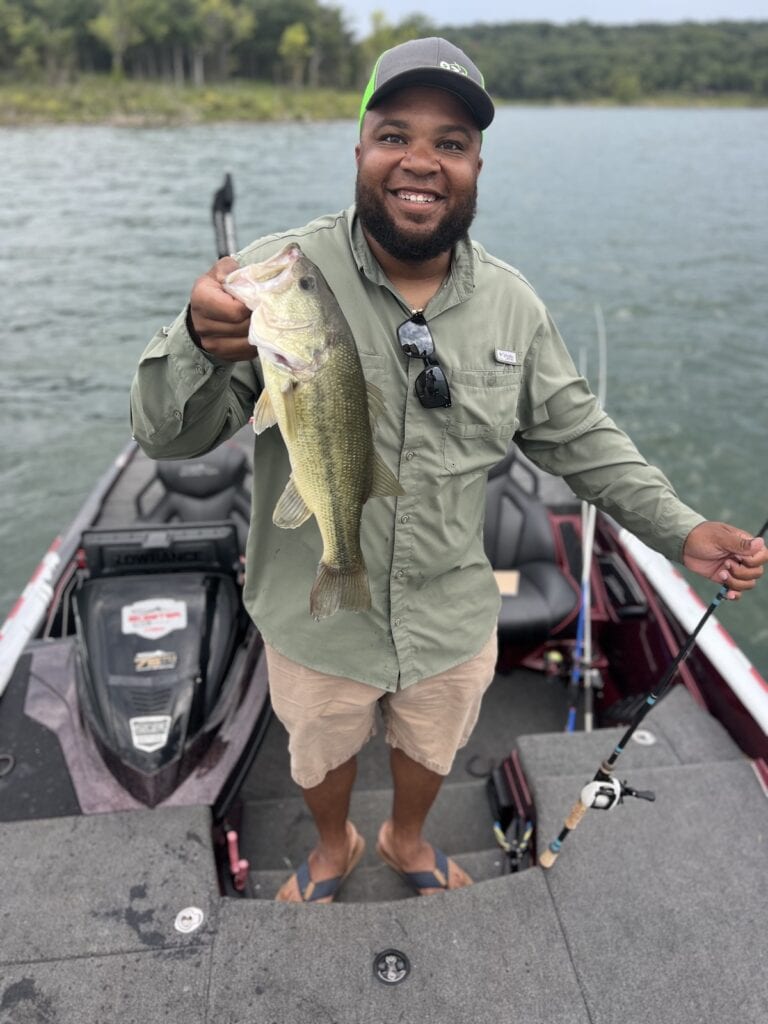
Largemouth bass dominate the shallows, chasing sunfish and anything else they can fit in their mouth.
While you’ll find largemouth all over the lake, during April and May around the spawn, you’ll most likely catch them in 1-10 feet of water in the coves and creeks with vegetation, brush piles, or abrupt depth changes.
At other times of the year, 10 to 25 feet of water is more productive, Teply said.
Mid-lake, around Chicken and Snake creeks and similar areas, is typically the best area for most types of bass fishing. There are some good bank-fishing spots in Corps access points, plus boat launches.
I use spinnerbaits, crankbaits, jigs, and bladed jigs for largemouth baits and the Texas or wacky rig for my soft-plastic rig choices. Once again, natural colors that resemble sunfish or shad work best.
Spotted Bass
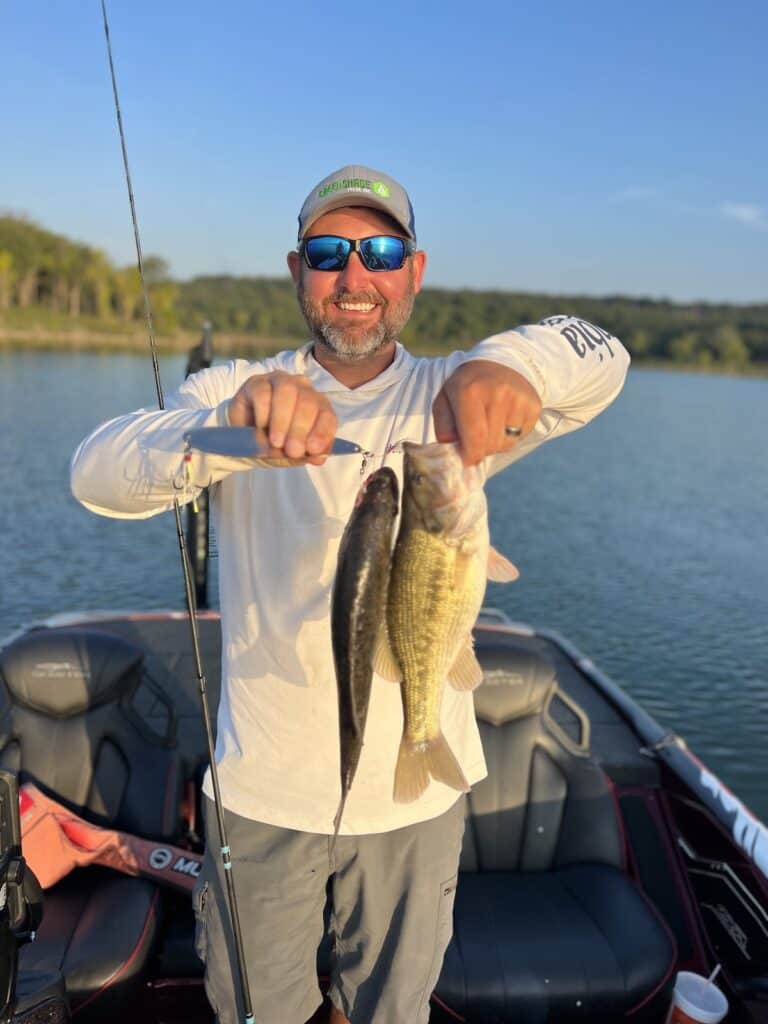
Spotted bass prefer to stay in the main lake or near access to deep water. I would begin by targeting the main lake points and the islands. If that didn’t work, I would follow the channel into the creeks.
Spots’ primary food source is shad, so using lures and colors closely resembling these baitfish will yield the best results on most days.
Spotted bass will congregate in huge schools from June to September, especially over brush piles in roughly 25 feet of water, Teply said.
Lake Tenkiller Crappie Fishing
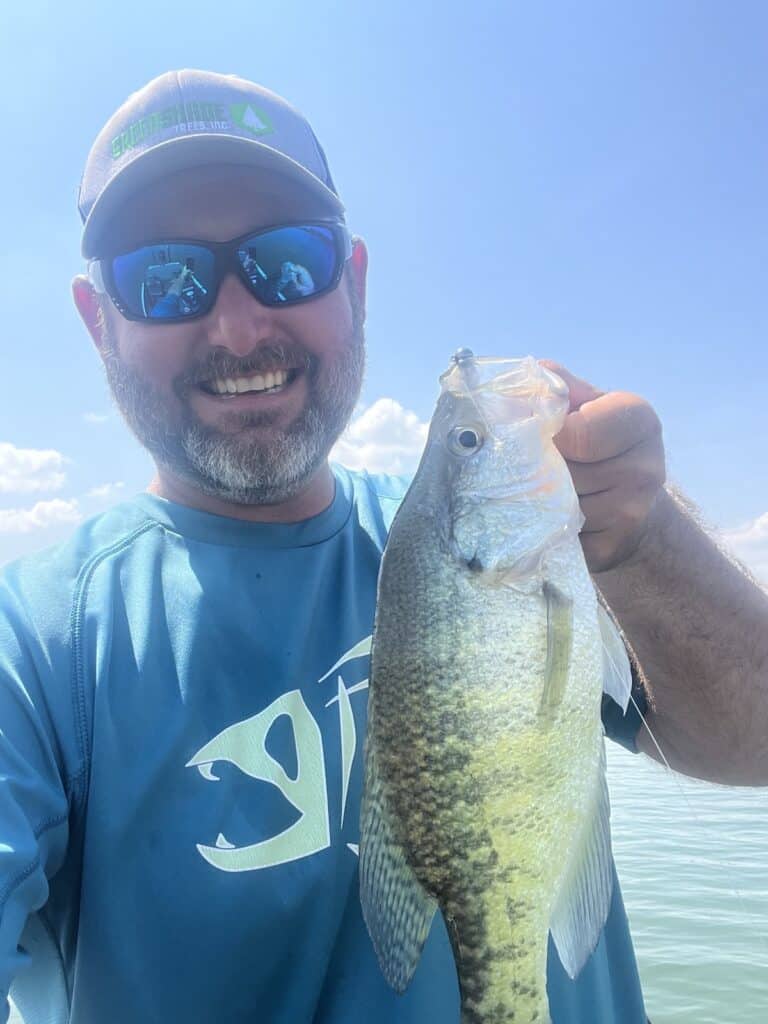
Tenkiller Ferry Lake has two species of crappie, the black and white crappie, with the latter usually the most common.
While they have slightly different preferences in water quality, they’re often caught in the same area using the same bait, so there isn’t a need to talk about them separately.
Both species grow to over 12 inches, making them perfect for filleting and frying up after a day of fishing. This is an excellent lake for big crappie, Teply said.
Crappies spawn in the spring on rocks and logs. If you’re a shore angler, this is the best time to catch them because once the spawn ends, they move to brush piles in 15-25 feet of water.
My favorite way to catch crappie is to cast crappie live minnows or sometimes jigs into brush piles. Another excellent spot to really catch crappie is around the lake’s submerged standing timber, Teply said.
When the bite is slow, you’ll sometimes need a slip bobber to allow your bait to sit in front of the crappie.
Many anglers overlook trolling for crappie using small crankbaits. This can be very effective in locating a school if you don’t have the latest sonar technologies.
Even in clear water, bright colors, like chartreuse and pink, are crappie favorites.
While Tenkiller narrowly missed out on our top Oklahoma crappie fishing impoundments, it’s still an excellent crappie lake and well worth spending a weekend here chasing these tasty fish.
Catch More Crappie
Catfishing at Tenkiller Ferry Lake
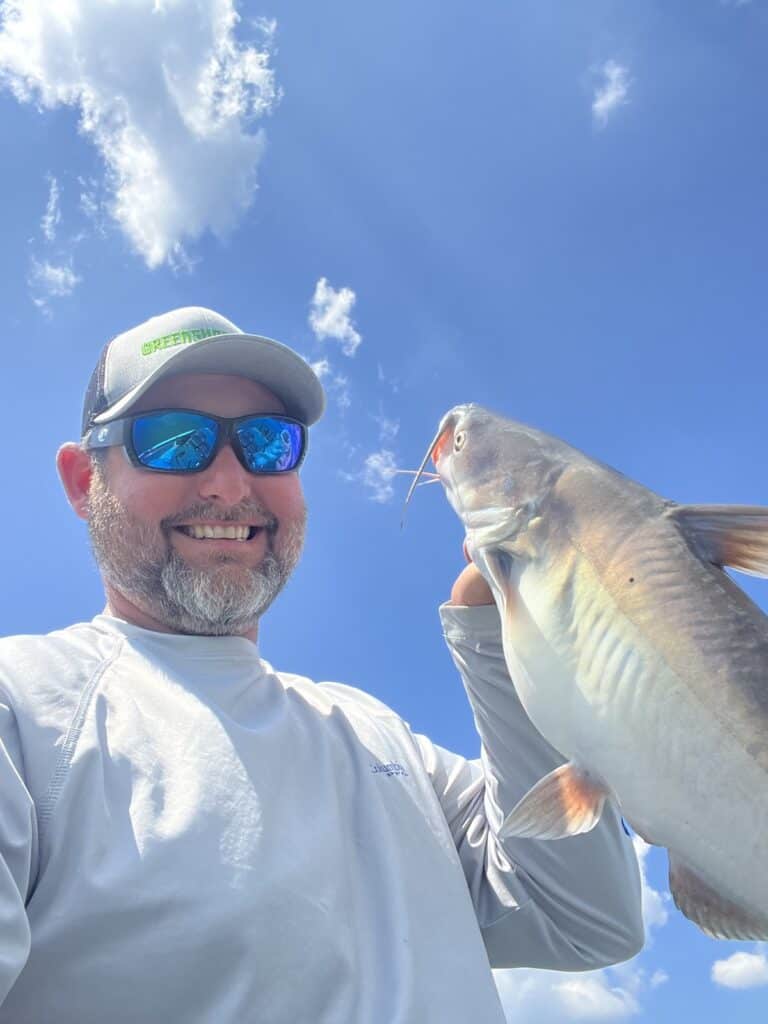
Oklahoma’s three big catfish species call Tenkiller home: channel, blue, and flathead catfish.
I’ve caught all three species using the same bait and out of the exact same location. However, you can often change up a few things to target a specific species.
Understanding the catfish spawning cycle will help you know where the fish are most likely to be, depending on the water temperature and time of year you’re fishing.
Catfish are among the last fish to spawn in late spring or early summer. They’re more difficult to catch this time of year because they’re focused on finding a nesting location and not feeding, but catfish will aggressively protect their nest once they’ve made one.
After they spawn in the shallows, 2-10 feet deep, catfish move back to deeper water, spending most of their time feeding on and near flats.
All three species use creek and river channels to move locations. Fishing in these areas is the best option during the summer and early fall.
The main ways to catch catfish at Tenkiller Lake are rod & reel, jugs, trotline, limb-line, and noodling.
Channel Catfish
As the smallest of the three major species, channel cats sometimes require smaller hooks and baits. They grow in the 5-15 pound range, but anglers catch a few larger channel catfish every year.
Hot dogs, small chunks of cut bait, chicken liver, and stink bait are some of the best channel catfish baits to put on a 5/0 or 6/0 hook.
Blue Catfish
Blues are the largest of the three species and, though rare, can exceed 100 pounds. Most will be in the 10-25-pound range, with a few in the 30+ pound range.
You’ll need larger hooks and baits to target the bigger fish. I like to use 8/0 hooks with large chunks of cut bait for blue catfish. Sometimes you’ll get the big blues to bite on live shad or bluegill.
Use cut bait in flats that are 20 to 30 feet of water, especially adjacent to a channel, and you’re likely to catch big blue cats, Teply said. Cut shad is the best, and the fresher the better.
“There’s so many of them in that lake,” he said. “They’ll wear you out.”
Flathead Catfish
Flatheads can also get over 100 pounds in ideal conditions; however, they’re primarily in the 10-20-pound range, with the occasional 50+ pounder hauled in.
Flatheads prefer live fish such as bluegill, but they will eat cut bait every once in a while. They’re also more solitary and found in brush piles and laydowns in creeks and up the river.
Flatheads are what most hand-fishermen target when noodling during the spawn.
Walleye Fishing at Tenkiller
The toothy walleye is also found in Tenkiller Ferry Lake, though it’s not a target fishery for most anglers here, Teply said. But if you do, walleye are a favorite of anglers fond of eating fresh-caught fish.
As with all other fish species, understanding where they should be relative to the shore is the best way to find a good spot to fish.
Walleye are generally deeper-water fish. However, in early spring, they move to shallow rocks to spawn. This is the best time to catch walleye from the bank.
After finishing their business, they return to the rocky points and flats where they feed for most of the summer and fall.
Trolling deep-diving crankbaits or bottom-bouncers is the best way to catch walleye at Lake Tenkiller. Like crappie, walleyes often respond to a flash of color like pink or chartreuse, as well as natural colors.
Once you’ve found some walleye, minnows on a slip bobber are tough to beat, but crappie jigs, jigging spoons, and hair jigs also work well when suspended or near the bottom.
Catch More Walleye
Walleye Fishing Techniques and Tips, including baits, lures and tackle.
White Bass Fishing
Oklahoma’s state fish, the white bass or sand bass, as we locals call them, are the most underrated fish in the state for eating.
However, they’re a blast to catch because they fight hard, and once you’ve caught one, there are likely several more nearby.
And there are a bunch of white bass in Tenkiller, which brings tons of eager anglers in the spring, especially, Teply said.
They run up the creeks and rivers to spawn in early spring before swimming back to the main lake to spend the summer.
I love casting for them using crankbaits, spinners, and jigs, but I don’t mind trolling with spoons and crankbaits for a great family outing.
If fishing by myself, I’ll start by trolling to find the school. Once I’ve located a group of sand bass, I’ll begin casting using the same lure I caught them on while trolling.
Silver and white are the best colors since sandies typically feed on shad.
Sunfish Fishing
There are several species of sunfish in Tenkiller. They all make for a fun time for the kids or anyone new to fishing.
Sunfish are often found near the shore in grassy or rocky areas at times and bite anything from small crappie jigs to live worms.
In the summer, move to 20 feet or deeper around brush piles and boat docks, Teply suggested.
I prefer to have worms when taking my daughter out because they’ve worked best, in my experience.
A small hook and bobber are all you need to have a fun time catching bluegill, redear sunfish, and green sunfish.
Catch More Bluegill and Sunfish
Check out our most productive and enjoyable bluegill and sunfish angling techniques, lures and baits.
Lake Tenkiller Trout Fishing (Tailwater)
The Lower Illinois River flows out of the Tenkiller Dam and is one of Oklahoma’s only year-round trout fisheries. I love floating in this river and trout fishing each summer.
Fly fishing and spinning gear are permitted here, but you must read the special trout regulations before heading to the water.
More: Read my complete guide to fishing the Lower Illinois River
Planning Your Trip
Another great thing about Tenkiller Ferry Lake is how accessible it is to visitors. Even though I live a couple of hours away, I’ve always found a boat ramp, bank access, and a place to stay whenever needed.
This ease of use is thanks to the many public access areas and campgrounds around the lake.
Boat Ramps & Bank Access
Whether you’re a boat or bank angler, you’ll have many options for boat launching and fishing from the shore.
On the southern end of the lake, Tenkiller State Park has a nice concrete boat ramp, and you can walk the bank and fish.
Cherokee Landing State Park has a small boat ramp and a long stretch of fishable shoreline on the lake’s northern end.
With several other public access and boat ramps in the middle section of the lake on the east and west sides, you won’t have any trouble finding your way to the water.
Where to Stay
There’s also no shortage of places to stay, whether you’re looking for a campsite, resort next to the water, or a hotel in town.
I usually stay at Tenkiller State Park, but I’ve also stayed at other campgrounds around the lake and the Lower Illinois River.
If camping isn’t your style, Talequah has several excellent hotels.
Acknowledgment
Thanks to Josh Teply Fishing for providing expert tips for this article.

